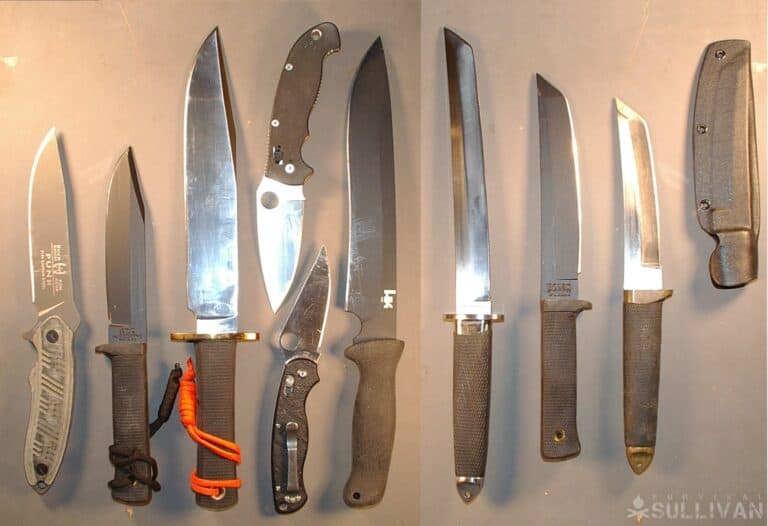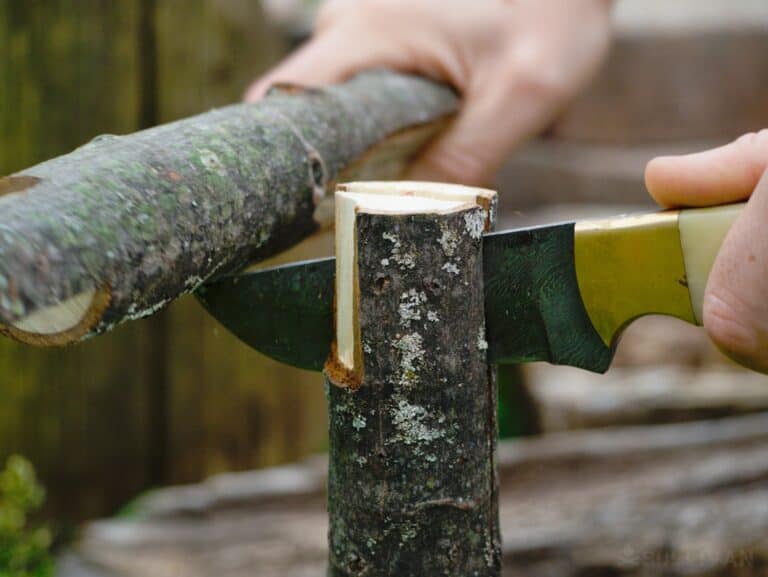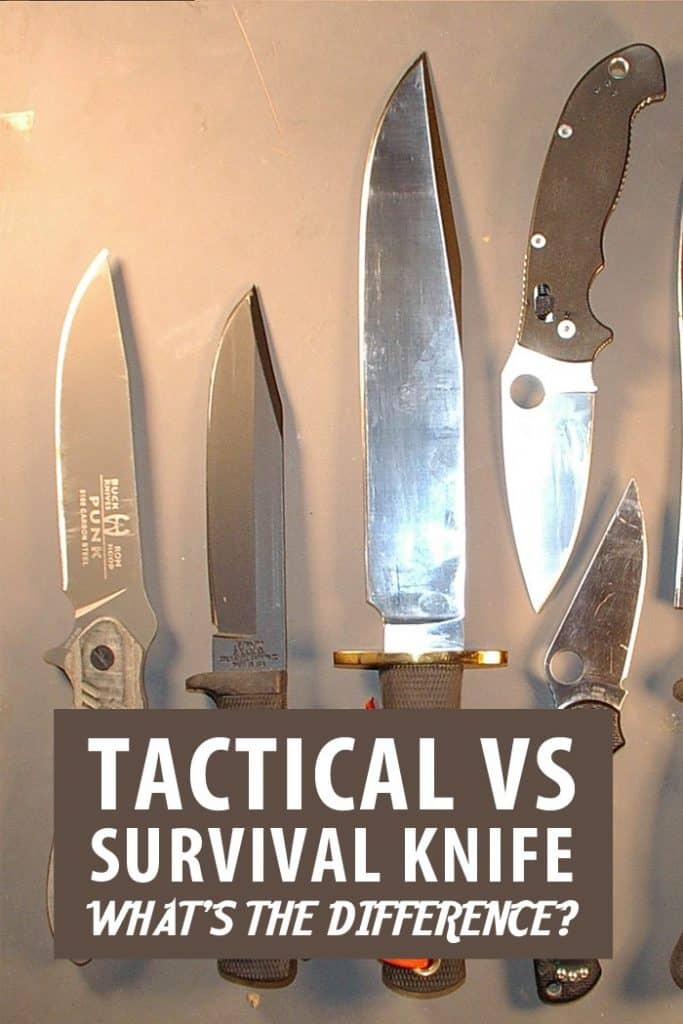Often in prepping circles the debate over what choice of knife one should carry as part of their bug-out equipment pops up. Should you carry a tactical knife or a survival knife? Both?
And what’s the difference, anyway? Isn’t one big knife as good as any other for prepping? Not necessarily! It pays to optimize your knife based on your needs, so read on and we’ll answer this perplexing question!

What’s the difference between a tactical and survival knife?
A tactical knife is optimized for “battlefield” tasks like fighting, breaking glass, slicing through fabrics like webbing, and cutting wire. A survival knife is optimized for tasks like shaving, chopping, batoning, and pounding, sometimes with a saw-tooth spine or compartment for supplies.
On a tactical knife, a strong tip is emphasized for piercing. On a survival knife, a strong spine and edge are emphasized to survive the rigors of processing wood.
Does it matter which one I pick?
It does! Just maybe not as much as you think.
While knife nuts will rampage all over forums all day and night debating the intricacies of knife configuration and design features, most normal earth people can concern themselves with only a few critical elements when evaluating a knife to serve as your “emergency” bug-out knife.
Any knife with an edge (and hopefully a point!) can work as a self-defense weapon in a pinch, though not all are optimized for the task.
Most knives will work for a time chopping and smashing through would with a baton, though not all will endure that treatment for very long. Your job is to evaluate what you are most likely to need during your anticipated emergency.
Survival Knives for Wooded Retreats
The first concern is whether or not you plan on escaping to or surviving for a time in a wooded area.
If you are going to be processing wood by the cord, and by processing I mean chopping, shaving, notching, batoning, etc., you should look for a dedicated survival knife, sometimes known as “bushcraft knives” for your purposes.
Knives like this are built like tanks, with especially thick, strong spines and edge geometry optimized to survive frequent use that would frankly be destructive for other kinds of knives.
The point may come in any style, but is often setup for control and precision; the better to whittle and shave with.
You might optionally find these knives with a “sawback” spine, allowing you to invert the knife and saw through branches in a pinch. Be advised the saw teeth interfere with batoning the knife.
A good survival knife will have a sweet spot handle, one designed to stay put in your hand with a little effort, but not so aggressively shaped or textured where it will cause blisters anytime soon.
Blisters can sideline you from working, and get infected easily! Smooth rubber, wood or G10 laminate are popular options.
It is up to you if you want to go full Rambo and get a massive knife with a built in survival kit in the hollow handle, but I’ll tell you it is a bad idea- the loss of strength and structural integrity is not worth it.
Instead, opt for one with a large sheath that allows you to keep your survival accoutrement in it.
Tactical Knives for Urban Environments
Tactical knives are focused predominately on dealing with problems created by people, including people themselves!
A tactical knife is often built more slightly than a true survival knife to keep it lively in the hand for fighting and also to reduce the overall weight of a soldiers load.
Survival knives also often feature built in carbide or ceramic studs or short spikes on the pommel for shattering automobile glass as well as recessed cutters for quickly, cleanly and safely slicing through seatbelts and webbing on harnesses.
Tactical knives are strong, but as a type not as brutishly overbuilt and massive as survival knives.
A keen edge is favored far more highly compared to a survival knife as is a dagger sharp yet sturdy point; all the better to open a vein, slice a strand of webbing or puncture a gas tank with.
Survival knives also allow you to do some batoning and prying with little fear of destroying the knife since they are often made from high-performance steels, but you will probably need to touch up the edge after a spell.

A proper tactical knife will have a blade profile optimized to be as slick and as snagless as possible both to make insertion as easy as possible but also to minimize the chance of fouling up and tangling on the withdrawal.
One major difference between survival and tactical knives is the handle and scales of a tactical knife is often aggressively contoured to lock into the hand and seriously textured to boot.
The idea is one can take no chances on losing or dropping the knife during its intended use, and the presence of gloves as well as the typically short duration of engagements they are used in outweighs the risk of blisters.
Never choose a dorky tactical knife with an odd blade, useless prongs and protrusions or any such nonsense. All business, all the time is the hallmark of a tactical knife!
Hybrids
There are some knife styles that combine the features of both breeds into a do-all knife you can take to war or the backcountry. One such early example is the legendarily infamous bowie knife, used to terrible effect in the sandbar duel by the eponymous Jim Bowie.
These massive, durable knives are right at home processing game and wood afield and make for a veritable short sword in a fight, even if their weight can work against them.
Nonetheless, with a keen point and the length to skewer a man, and the heft to rend limbs, branches and skulls, some knives definitely blur the line!
Tactical and survival knives fill two complementary but distinct roles for preppers, and your choice of one or the other should hinge on whether you plan to survive a SHTF situation in the untrodden forests of nature or the gleaming concrete jungles of man.


Tom Marlowe practically grew up with a gun in his hand, and has held all kinds of jobs in the gun industry: range safety, sales, instruction and consulting, Tom has the experience to help civilian shooters figure out what will work best for them.

It amazes me that most of the Mountain Men had a single knife….a Green River blade. If I only have one then that is it.
well written, but jumping the shark.
A good pair of scissors is even handier, trust me.